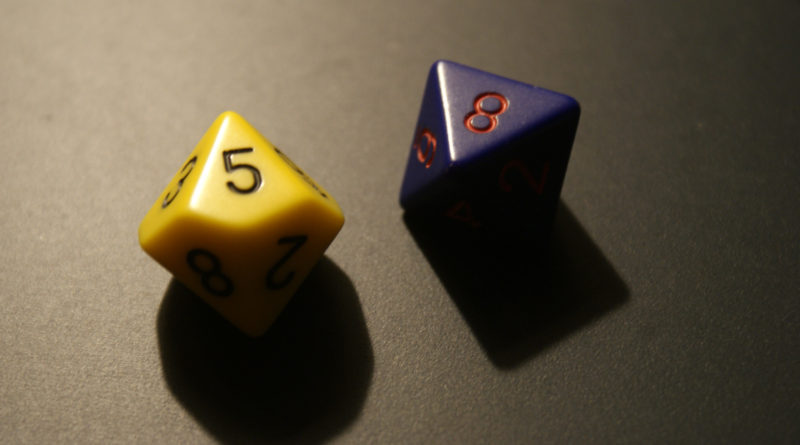How to Play Without d20 Using d10 and Control Dice
By G. Bruce MacKenzie
Back in ye olden days of gore, that’s a pun, we novices in the art of the game were presented with such secrets that were only passed down by actually playing. Those were the heady days of High School in the late 1970s. In those days we had a d20 sure enough but unlike modern dice the numbers went from 1-10, twice. The dice were not conveniently numbered from 1 to 20 as they are now.
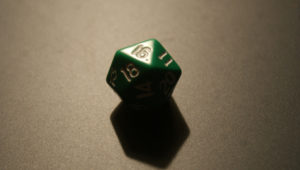
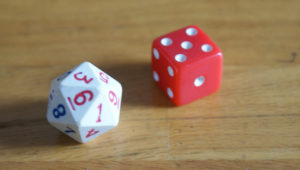
At the game I joined everyone rolled the said and un-inked d20 with a d6 control dice. In order to get a result of 11 through 20 with the d6 on a roll of 4-6 one added 10 to the result of the d20. So 6 +10 = 16. Cool huh. Well, it was what we had at the time and to the best of my recollection it did not occur to we players then to colour each sequence of numbers differently. That was only done later on using crayons or for the truly skilled, with paint.
So, the chance of actually getting any one number on a d20 is 1 in 20. Since on the old dice the numbers are repeated twice the chance of rolling a 6 for example is actually 2 in 20. However, using the d6 control dice means that the chance of adding 10 to that number is 3 out of 6, or 50%. With a fully numbered d20, if I am not mistaken, the odds of getting a number 11 through 20 is still the same, 50%. The chance of rolling exactly 16 is still 1 in 20. If you were thinking that was about as much as I wanted to bore you with math you are sadly mistaken, oh well, you are hooked now.
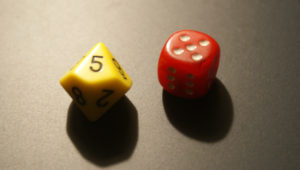
What did not seemingly occur to me at the time was to investigate the math behind the control dice a little further and push how a control dice result might be used to different effect. That is really the point of this particular article only I bet you really didn’t know I was going there, surprise!
These days the best way to simulate the old un-inked d20 dice is to use a d10 and a control dice the type of which we will decide is d6 for the time being. Consider following, whether or not one adds 10 to the result of the d10 can be modified by the result of the control dice. Why, whatever do I mean? Ordinarily a result of 4 through 6 would indicate that 10 should be summed with the result of the d10 but what if we increased or decreased the range of values?
As we can see from the following table changing the range of values of the control dice type, d6, changes the outcome.
|
d6 Control Dice Result |
How many Pips? |
Percent |
|
1-6 |
6 out of 6 |
100 % |
|
2-6 |
5 out of 6 |
83.33 % |
|
3-6 |
4 out of 6 |
66.66 % |
|
4-6 |
3 out of 6 |
50 % |
|
5-6 |
2 out of 6 |
33.33 % |
|
6 |
1 out of 6 |
16.66 % |
Note that this table is constructed in keeping with the game’s more is better rule trope.
How to arrive at a percentage value; count the pips (4) divide by total number of pips (6) times 100 equals the percentage, thus 4/6 = 0.6666 x 100 = 66.66%
So, what can we actually do with this math? It is well within the purview of the Ref to adjudicate their game using house rules, as they see fit. I would point out however that if one does this it is best to write down some guidelines and follow them consistently. That way you can wave the house rule under some squawking players nose and tell them you are being consistent and more than fair, even generous. For example:
The d20 will not be used for attack rolls. Instead, a d10 and d6 control dice will be used. For the first three player levels the Ref opts to grant the players the opportunity to add 10 to the result of the d10 if the d6 control dice result is 3-6. Monsters of certain types (as designated by the Ref in a list) must roll 5-6 if they are to add 10. Those monsters not on the list must roll 4-6. Upon Players reaching 4th level, or for monsters of 4 hit dice or better, a control dice result of 4-6 will be used to add 10 to the result of the d10.
This kind of house ruling spices up the play of the game and initially grants the players a benefit at low level.
A d6 does not have to be used as the control dice, in fact, the percentage spread can grant greater control over the result if other dice are used, queue the d8.
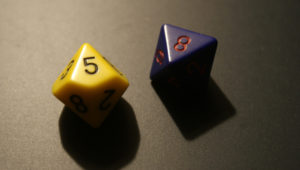
|
d8 Control Dice Result |
How many Pips? |
Percent |
|
1-8 |
8 out of 8 |
100 % |
|
2-8 |
7 out of 8 |
87.5% |
|
3-8 |
6 out of 8 |
75 % |
|
4-8 |
5 out of 8 |
62.5% |
|
5-8 |
4 out of 8 |
50 % |
|
6-8 |
3 out of 8 |
37.5 % |
|
7-8 |
2 out of 8 |
25 % |
|
8 |
1 out of 8 |
12.5 % |
The chance of adding 10 could be reduced from 66.66% to 62.5% for example were d8 used instead of d6. Our house rule for a d8 control dice might look like the following:
The d20 will not be used for attack rolls. Instead, a d10 and d8 control dice will be used. For the first three player levels the Ref opts to grant the players the opportunity to add 10 to the result of the d10 if the d6 control dice result is 4-8. Monsters of certain types (as designated by the Ref in a list) must roll 6-8 if they are to add 10. Those monsters not on the list must roll 5-8. Upon Players reaching 4th level, or for monsters of 4 hit dice or better, a control dice result of 5-8 will be used to add 10 to the result of the d10.
Again, as the Ref you can house rule your game any way that players will find acceptable to them. The above house rules will take the sting out of the early part of the game but I would point out that additional uses for context can be imagined for the control dice. A Ref might decide that Elves and Wizards should have an advantage fighting vs. supernatural creatures, perhaps such creatures could be assigned to a list. Consider the following house rule:
When a Wizard or Elf (classed or unclassed) are in combat vs. Supernatural Monsters (consult the Ref’s list) such creatures must use a d8 control dice when they attack and a control dice result of 7-8 will be used to add 10 to the result of the d10.
This kind of rule might be used for very special creatures. Of course the players need not have things all their own way and such rules can just as easily be applied in a way that benefits a particular kind of monster when the players attack.
When a Wizard or Elf (classed or unclassed) are in combat vs. insert specific very horrible monster name here which is the nemesis of a character class such a player will use a d8 control dice when they attack and a control dice result of 7-8 will be used to add 10 to the result of the d10.
A good bit of fun can be invoked by giving insignificant creatures that are not otherwise a challenge such features, they need not have a plethora of hit dice…
Additional house rules for context can be imagined:
-
perhaps a benefit is granted by a magic item, or
-
applied as a penalty as part of a cursed weapon, or
-
calling upon a patron being/deity to aid one in an attack, or
-
beneficial when a character fights with a particular weapon, or
-
beneficial in limited circumstances such as when a character fights with a particular weapon vs. a particular monster or list of monsters, or
-
perhaps monsters which are larger than man-size have difficulty attacking small characters such as Halflings or Dwarfs.
-
perhaps man-like characters have difficulty attacking other man-like characters due to the defender’s superlative swordsmanship, aka parrying ability.
-
perhaps when a character reaches a low hit point threshold, or invokes berserker rage, they attack or defend with desperate fury.
The control dice might also be used to trigger combat events when an attack roll is unsuccessful. Events can be used to spice up the game, consider the following house rules:
Attacker Combat Event Table:
|
Value of the d10 |
% |
Attacker Combat Event |
|
1 |
10% |
Fear Check |
|
2-3 |
20% |
Retreat 1” |
|
4-6 |
30% |
Attack of Opportunity |
|
7-10 |
40% |
n/a |
Attack of Opportunity – a character’s attack was so awkward one adjacent enemy is granted a bonus combat attack this round.
Berserker Rule – A Berserker rage may be deliberately invoked with a successful Saving Throw vs. Magic by characters of the Fighter Class, or invoked by other rules. Berserker Rage lasts 1d6 rounds. When a Berserk character attacks a control dice result of 3-8 is used to add 10 to the result of the d10. When a Berserk character is being attacked a control dice result of 6-8 is used to add 10 to the result of the d10.
Fear Check – when the attacking character has only 1-3 hit points remaining, and fails a saving throw vs. poison, at the beginning of the following round they run away for 2d6 rounds. If the character is intelligent, and cannot run away, they surrender or berserk depending upon whether they can reasonably expect a surrender to be accepted. Characters of animal intelligence that cannot run away instead berserk.
n/a – nothing at all happens, sigh…
Retreat 1” the attacker retreats 1”, move the attacker’s figure one square backward. The defender’s figure in an adjacent square may, at the defender’s option, be freely moved into the vacated square.
Conclusion
Well, now you can play like back in the day.
